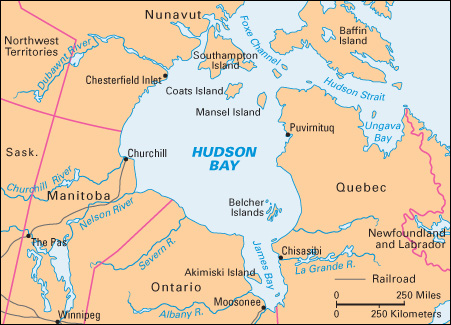Hudson’s Bay Company is a business firm that became famous for its role in western Canadian history. It was founded in London in 1670 to establish a fur trade in what is now the Hudson Bay region. Today, Hudson’s Bay Company ranks as one of Canada’s largest corporations.

Beginnings.
North American furs were in high demand in Europe during the 1600’s. A group of English merchants and nobles founded the Hudson’s Bay Company with the help of two French fur traders, Médard Chouart (known as Sieur des Groseilliers) and Pierre Esprit Radisson. The traders knew that the Hudson Bay region was a source of high-quality furs. After a quarrel with the French colonial government in Quebec over profits and taxes, they had offered their services to Charles II of England.
In 1668, Groseilliers helped direct a trading expedition to the Hudson Bay region. The expedition was so successful that the king gave the Hudson’s Bay Company a charter in 1670. The firm received sole trading rights in all lands drained by the streams that flowed into Hudson Bay. Company employees built trading posts along the bay. Native American traders traveled to these posts to exchange furs for such European goods as beads, blankets, guns, iron pots, knives, lace, mirrors, and twine.

Growth and problems.
Until the late 1700’s, the Hudson’s Bay Company only had posts along the shores of Hudson Bay. Meanwhile, French fur traders from Montreal moved steadily westward along rivers and lakes. They competed with the English for furs and for buyers. In 1763, as a result of the Indian wars, Britain took control of most French territory in North America. However, the fur-trading community that had developed in Montreal continued to compete with the British company.
In the late 1770’s, independent fur traders from Montreal started combining their operations. In 1784, they adopted the name North West Company. By 1800, the new company had begun competing seriously with the Hudson’s Bay Company. In response to this challenge, the Hudson’s Bay Company established a network of trading posts throughout western Canada.
In 1821, the two rival companies combined under the name Hudson’s Bay Company. By that time, fur traders had explored all the way to the Pacific and Arctic coasts of Canada. The new company was placed under the leadership of Sir George Simpson. It held full land and trading rights in much of western British North America until 1870. That year, the company gave the British government much of the territory granted by its charter. The government transferred the land to the Dominion of Canada, a newly created federation of four Canadian provinces. The company received about $11/2 million and certain areas of land in western Canada. The Hudson’s Bay Company later sold this land to settlers.
Recent developments.
The Hudson’s Bay Company ended its fur-trading business in 1989. Today, it ranks as Canada’s largest department store retailer. The company owns a chain of department stores throughout Canada.
